Hoorn 作者: 来源: 发布时间:2021-10-20
一、人口,面积,所属地区
Location in North Holland
Coordinates: 52°39′12″N 05°04′24″E
Country Netherlands
Province North Holland
Area
• Total 53.25 km2 (20.56 sq mi)
• Land 20.25 km2 (7.82 sq mi)
• Water 33.00 km2 (12.74 sq mi)
Elevation −1 m (−3 ft)
Population (January 2019)
• Total 73,004
• Density 3,605/km2 (9,340/sq mi)
Demonym(s) Horinees
Time zone UTC+1 (CET)
• Summer (DST) UTC+2 (CEST)
Postcode 1620–1628, 1689, 1695
Area code 0229
Hoorn is a municipality and a town in the Netherlands, in the province of North Holland. It is located on the Markermeer, 35 kilometres (22 mi) north of Amsterdam, and acquired city rights in 1357. Hoorn had a population of 73,004 in 2019. The area of the municipality is 53.25 km2 (20.56 sq mi) of which 33.00 km2 (12.74 sq mi) consists of water, mainly the Markermeer. The municipality consists of the following villages and/or districts: Blokker, Hoorn, Zwaag, and parts of Bangert and De Hulk.
Cape Horn, the most southerly point of the Americas, was named after the town by Willem Schouten, who navigated the cape in 1616.
The Hoorn Islands of the French overseas collectivity of Wallis and Futuna in Oceania are also named after this city.

skyline of Hoorn
二、自然地理
Railway connections
Hoorn is connected to the Dutch railway network, and has two stations: Hoorn and Hoorn Kersenboogerd. Also, it is the starting point of the historical railway between Hoorn and Medemblik.
Hoorn–Medemblik heritage railway
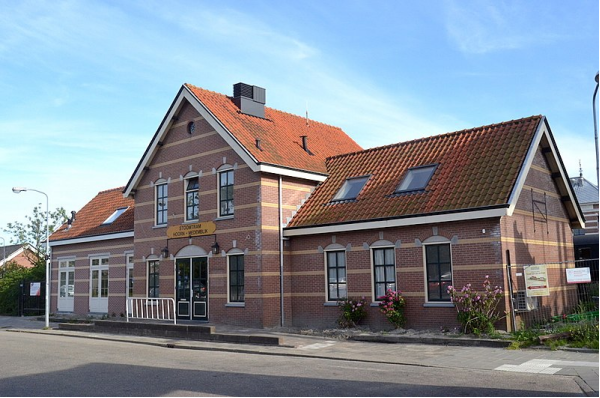
Tramstation Hoorn; july 2015
The Hoorn–Medemblik heritage railway operated by the Museumstoomtram Hoorn Medemblik is a heritage railway in the Netherlands. It runs from Hoorn to Medemblik, a distance of about 20 km.
History
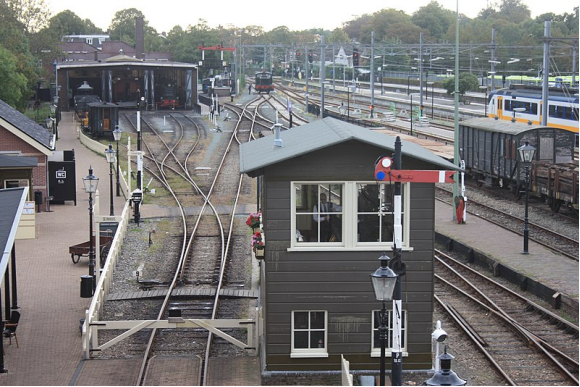
Signal hut and sidings, Hoorn Heritage Railway
The original railway line was operated by Locaalspoorwegmaatschappij Hollands Noorderkwartier (1884 - 1935). The line was opened on 3 November 1887. The track followed a circuitous route to reduce the amount of land that had to be compulsorily purchased. The line used steam traction; diesel traction being introduced in 1929.
The line was closed to passenger services from 1 January 1936 to 29 May 1940.
On 5 January 1941 the line was permanently closed to passenger services; as was the railway station in Medemblik
Route
Distance (km) Station name
Hoorn
2 Westerblokker
4 Zwaag
5 Zwaagdijk
6 Wognum- Nibbixwoud
7 Wijzend
9 Benningbroek- Sijbekarspel
10 Abbekerk- Lambertschaag
14 Midwoud- Oostwoud
16 Twisk
18 Opperdoes
19 Opperdoes Oosteinde
20 Medemblik
Heritage railway
Today, the railway is operated as a tourist attraction. The centrepiece of its collection is the former Nederlandse Spoorwegen locomotive 7742 Bello, the only preserved light steam engine in the Netherlands. Other steam locomotives in running order include three tramway engines, two of which are enclosed tram engines (steam dummies). The remaining ones are: three industrial engines; a German engine which is now being rebuilt as a replica of a Dutch railway shunting engine (of a series of which several also served on steam tramways); and a locomotive of industrial type which served at a steam tram company in Zuid-Holland, still awaiting restoration.
Seven of the nine steam locomotives are official Dutch railway monuments.
NS 7742 and the two enclosed tram engines are in regular use: Bello mainly in the peak season afternoon train, and the two steam dummies mainly in the 10 o' clock train (Tue/Wed/Thu during peak season).
Eight steam tram carriages are in regular service, as well as several steam tram goods wagons.
Bello and the three tramway engines originate from the provinces Noord-Holland, Zuid-Holland and Limburg. The serviceable steam tram carriages originate from the provinces Friesland, Gelderland, Noord-Holland, Zuid-Holland and Zeeland.
The livery and presentation of the cars is as they were in 1926.
The station is twinned with the Bluebell Railway in England. The ride between Hoorn and Medemblik is often combined by tourists with a trip from Medemblik to Enkhuizen by boat.
On the disused side of platform 2 of Huddersfield railway station in northern England, an old carriage is bolted to the ground, and set in its window is a Dutch plaque commemorating 100 years of Stoomtram Hoorn - Medemblik.
Film
The railway was used as film location for the 1979 movie The Riddle of the Sands: the station building of 'Emden' was in fact Medemblik, and Twisk was used to represent 'Bensersiel'.
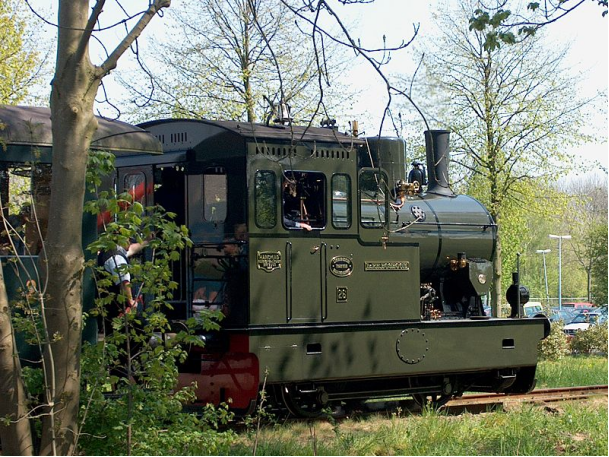
Loc 26 - "Ir. P.H. Bosboom"
Hoorn Kersenboogerd railway station
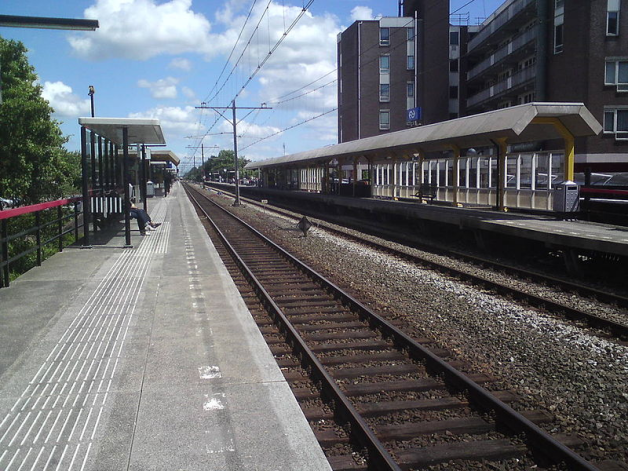
Hoorn Kersenboogerd is a suburban railway station, in the Kersenboogerd district in Hoorn, Netherlands. The station opened on 29 May 1983, and is on the Zaandam–Enkhuizen railway. About 1 km east of the station is a siding where the "stoptrein" (all-station service) to and from to Hoofddorp can be turned around. From this point the line to Enkhuizen becomes single track. The station is located in the east of Hoorn, and was originally referred to in the plans as Hoorn Oost.
Train services
The following services currently call at Hoorn Kersenboogerd:
-- 2x per hour intercity service Enkhuizen - Hoorn – Amsterdam Centraal – Utrecht Centraal – 's-Hertogenbosch – Eindhoven – Heerlen / Roermond – Maastricht
-- 2x per hour local service (sprinter) Leiden Centraal - Schiphol Airport - Zaandam - Hoorn Kersenboogerd
三、经济发展和规模
Total » Total » A-U All economic activities - Hoorn - Electricity. delivered
161,242.00
1,000 kWh in 2018
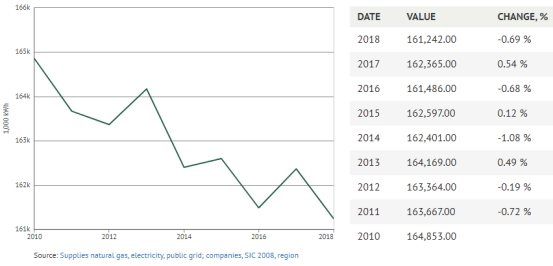
Total » Total » A-U All economic activities - Hoorn - Natural gas, delivered
19,935.00
1,000 m3 in 2018
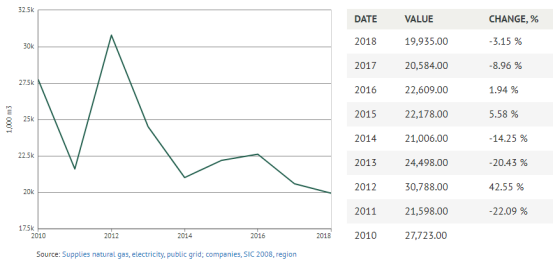
All companies - Hoorn
5,255.00
in 2011
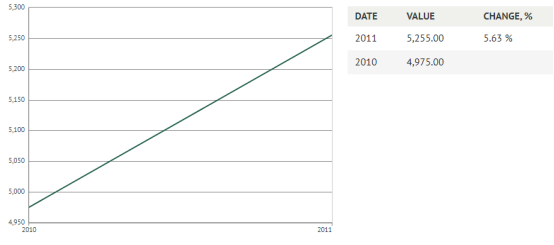
Reference: https://knoema.com/search?query=Hoorn+economy&pageIndex=&scope=&term=&correct=&source=Header
四、产业特点/重点项目
Overview programs
Programs on which a positive decision has been taken are included in the project portfolio of the municipality of Hoorn. These programs are explained in this part of the budget. Programs are aimed at achieving objectives, for which funds are made available for a period of several years.
The (long-term) objective is explained for each program. It also describes which activities will be carried out in 2020 and which concrete results are expected in 2020.
1, Grote Waal Strong Together
The Grote Waal is a future-proof neighborhood. In 2022 there will be more social involvement in the Grote Waal. We do this by, among other things, strengthening the social structure.
What are we going to do for that?
-- A new layout of Dwaalpark provides a recreational, sporting and cultural function.
-- Facilitating an annual festival day for children organized by various collaborating parties.
-- Establishment of a children's district council (Kindkracht).
-- More supervision of the safety of residents in the neighborhoods will start with Siriusstraat and Astronautenweg.
-- Strengthening networks in the neighborhood.
-- Mapping existing meeting (spaces) in the neighborhood.
-- Completion of 192 apartments in the Siriusstraat.
2, Hoorn-Noord / Venenlaankwartier
The aim of this program is to maintain the quality of the neighborhood, to increase it where necessary and to promote coexistence. We do this in collaboration with the district from the strength of the district, all in physical, economic and social terms.
What are we going to do for that?
-- Working towards the issue of the environmental permit Holenkwartier.
-- Working towards the realization of two IKCs (Maria School and Montessori School) in combination with other cost-bearing functions.
-- Give other projects the space to improve the quality of the housing stock (in detail of what kind of city we want to be).
-- Start with the actual implementation of replacement of sewerage in both Hoorn-Noord and Venenlaankwartier.
--Redesigning / improving the public area (including Venenlaan, measures as a result of recalibration of the Traffic circulation plan for the Venenlaankwartier, facilitating measures to promote encounters and contact, implementing the results of the Green Vision linked to the wishes of the residents), including the climate adaptation task.
-- Implement the project initiatives in the neighborhood together with residents and organization / institutions.
-- After the second WIJKKIJK implement the festival in the district (investigate foundation form).
-- Follow-up with the chain partners on the results of the study aimed at living independently for longer and aging well in the neighborhood (study 2019).
-- Evaluate the operation of the Network and Partnership and provide recommendations for the future.
All this using the power of the city.
The program is related to the following components of the policy budget: Spatial planning and public housing , Traffic, Transport and Water Management , Education , Art and Culture , Social facilities and social services and the management programs.
The various policy fields and the area-oriented program are coordinated, so that policy and what emerges in the program leads to targeted implementation in the neighborhood.
3, Gate of Hoorn
The goal of the Poort van Hoorn is to develop and realize a high-quality and comfortable multimodal hub, creating an attractive urban environment with space for homes and other urban functions, coupled with high-quality public space.
To achieve this objective, we want to create two powerful residential environments to the north and south of the railway, give the traverse a function as 'Podium', restore the canal structure on the south side of the station, and ensure that the Poort van Hoorn is functional. significance for the whole of Hoorn and the West Friesland region, and finally that multimodal accessibility is tailor-made for all target groups and modes of transport.
What are we going to do for that?
-- The conclusion of a cooperation agreement between the municipality, NS, ProRail and the Province of North Holland.
-- Drafting an urban design in collaboration between the municipality, NS, ProRail and the Province of North Holland.
-- Concluding a realization / anterior agreement between the municipality, NS, ProRail and the Province of North Holland.
-- Preparing and, if possible, putting a zoning plan into practice that enables the objective to be achieved.
4, Waterfront
The aim of this program is to make even better use of the location of Hoorn on the water and to improve accessibility by water.
What are we going to do for that?
-- Establishing Definitive design of the City Beach and bicycle / footpath Westerdijk.
-- Implementation of work on Stadsstrand and bicycle / footpath Westerdijk.
-- Application for a subsidy for the Stadsstrand and bicycle / footpath Westerdijk.
-- Applications for a definitive implementation credit.
-- Start monitoring bathing water for bathing water profile.
-- Adjusting the zoning plan and applying for permits.
-- Prepare catering city beach.
-- Spatial development of Marina Cape Hoorn (Schelphoek).
--Better use of the qualities of the port by strengthening the organization, improving services and using initiatives to strengthen (water) recreation and tourism.
-- Control / supervision of nuisance coastal area from Julianapark to Schouwburg.
--Together with central government, provinces, municipalities and private parties (water sports associations, commercial and association harbors), weed fountain weeds in the Markermeer (implement cooperation agreement).
-- Stimulating the use of pondweed as a raw material.
--Realize swimming water location Visserseiland.
There is a relationship with the following components of the policy budget: Public Order and Safety , Traffic, transport and water management and Economy (policy field tourism) .
5, Opportunities for the Kersenboogerd
The aim of this program is to improve the quality of the living, working and living environment in the Kersenboogerd district.
What are we going to do for that?
Implementation of projects and activities from the program / implementation plan adopted by the Council in December 2018 :
-- Implementation of the joint vision of the municipality and Intermaris of the Kersenboogerd central area. This vision will be presented to the council at the end of 2019. In 2020 we will translate the vision into a plan of action with concrete actions.
-- Implementation of the Social Opportunities project for the central area.
-- Redesign Kasteellaan and surroundings. The planning depends on the result of the feasibility study for the construction of a heat network in the Kersenboogerd (mid-June 2020).
-- Execution of project jobs “Clean, whole and safe”, “Resident initiatives” and “Sports initiatives”.
--Improve various traffic junctions based on wishes from the neighborhood.
--Implement measures from Green Vision that meet the wishes of the neighborhood.
We do this in collaboration with the district from the strength of the district together with our partners.
The social domain policy area and the area-oriented program are coordinated, so that policy and what emerges in the program lead to targeted implementation in the neighborhood.
The program is approached integrally and drawn up and implemented together with the district.
There is a relationship with the following components of the policy budget: Public Order and Safety , Traffic, Transport and Water Management , Social Services and Social Services , Spatial Planning and Housing and Sustainability .
6, Durability
The aim is a climate-neutral city in 2040. To achieve this goal, a program has been set up consisting of three pillars: (1) Energy transition, (2) Circular economy, (3) Climate adaptation and biodiversity. Cooperation at regional level is necessary to establish the right connections and measures and to implement all three pillars of the Sustainable City program. The starting point is starting locally and expanding regionally.
1. Energy
transition The energy transition consists of four parts: savings, sustainable generation, heat and mobility. Together, the activities in these four components will lead to an energy-neutral Hoorn in 2040. In this context, cooperation with residents and companies within the municipality, as well as with regional municipalities and stakeholders HNNK, Liander, PWN, province and regional companies, is necessary in order to actually achieve the objectives already set. . These objectives are:
Objectives Hoorn
-- An energy-neutral city in 2040.
-- 2022 sustainable energy generation 23%.
-- 2022 energy savings 5%.
-- 2022 CO2 emissions -15%.
Westfriesland objectives
--Energy-neutral West Friesland in 2040.
National legal obligations 2020 and beyond
-- 2020 Regional Mobility Plan.
-- 2020 (June) concept RES offer to central government.
-- 2021 (March) RES offer to Rich renewable energy generation on land: 35 Twh. (region Westfriesland).
-- 2021 Heat Vision Transition (now adopted by the Council).
-- 2024 Revision of Heat Vision Transition.
-- 2025 Projects renewable energy RES on land secured in the Environmental Act.
-- 2030 RES renewable projects on land realized.
-- 2030 CO2 reduction 49%.
-- Municipal real estate Label C 2023, Label A 2030 and Label EN 2040.
-- 2050 built environment natural gas free.
-- 2050 35% energy savings.
2. Circular economy
A fully circular economy means that a raw material is prevented from becoming waste. This not only saves raw materials, it also contributes to less CO2 emissions and stimulates chain cooperation, employment and (process) innovation.
Objective Hoorn
-- Circular in 2040 ..
National legal obligations 2020 and beyond
-- 2025 ban on waste incineration.
-- Reduce the use of primary raw materials by 50% by 2030.
-- By 2030 the amount of food that households, companies and catering establishments throw away will be halved.
-- 2050 Circular Netherlands.
3. Climate
adaptation and biodiversity The basis for shaping climate adaptation is anchored in the Delta Plan on Spatial Adaptation. The themes are flooding, heat stress, drought, floods and subsidence.
Westfriesland objective
-- Climate-proof and water-robust Westfriesland in 2050.
National legal obligation 2020 and beyond
-- Implementation program Delta Plan for Spatial Adaptation 2020.
-- Risk dialogue 2020 (part of the climate stress test).
-- Climate stress test 2020.
-- Climate-proof and water-robust design in 2050.
What are we going to do for that?
We want to take the following steps and achieve results for the three pillars:
1. Energy transition
Steps / process
-- Implementation of the program '' Hoorn saves' existing construction via the neighborhood programs and business parks.
-- Making a RES offer for sustainable generation on land in collaboration with the --Noord-Holland-Noord regions.
-- Stimulating the installation of solar panels via large-scale generation of housing associations and private home owners.
-- Register a testing ground for natural gas-free neighborhoods with the Ministry of the Interior and Kingdom Relations.
Result
-- Established implementation program West Frisian Energy Compass (WEK).
-- Established and operative revolving fund.
-- Basic principles of the collective district heating district Kersenboogerd have been established.
-- Municipal real estate made available for renewable generation.
-- Increased ceiling for sustainability loans for private individuals.
2. Circular Economy
Steps / process
-- Drafting and implementing the Raw Materials Plan for household waste.
-- Determine focus, ambition and opportunities regarding the topic circular.
-- Explore possibilities for approaching circularity at West Frisian level.
-- Implement action plan circular North Holland North.
-- Stimulating innovation by supporting the Clean2A project.
Result
-- Established implementation program circular Hoorn.
-- Sustaining two Hoorn events with a focus on circularity.
3. Climate adaptation and biodiversity
Steps / process
-- Implement the Delta Plan on Spatial Climate Adaptation: climate stress test to identify vulnerabilities, draw up risk dialogue and implementation program. In anticipation of the Delta Plan, climate adaptation measures are included where possible.
-- Drawing up an implementation plan for the Green Vision, which will discuss which measures will be taken in the field of biodiversity and climate adaptation in public green areas.
Result
-- Adopted implementation program for climate adaptation.
Communication
Steps / process
-- Translate the established communication strategy Sustainable City into action plans at local and neighborhood level.
-- Offering training and courses for the three pillars of the Sustainable City program in collaboration with the WFA.
-- Investigate whether the budget cycle can be structured on the basis of the Global Goals.
Result
-- Education program for primary education in collaboration with external parties.
-- Communication campaign 'Hoorn saves'.
7, environmental code
As of January 1, 2021, the Environmental Act is in force. This law combines 26 laws of building, environment, water, spatial planning and nature into one new law. In 2021, an Environmental Vision will be drawn up for the entire municipality and an environmental plan will be drawn up for at least two areas appointed by the Council. Preparations for this will start in 2020.
As of 1 January 2021, the entire permit-issuing system has been redesigned so that residents and companies can gain clarity about their permit in an easy and fast way. We will implement an Environment Table for this.
The Environmental Act requires a different role from the organization, the college and the city council on various points. We will tackle the development of these roles together in 2020.
What are we going to do for that?
-- In order to be ready for granting permits in accordance with the Environmental Act on 1-1-2021, various work processes are being adapted so that complex permit applications can be processed within eight weeks.
-- We will simplify the requirements regarding licensing. Spatial policy is being adapted for this, including for simple building applications.
-- Courses and games are being developed for employees and the city council.
-- Various digital systems are being converted so that they meet the standard set by law and improve services.
-- Two (at least) two pilots with environmental plans are held.
-- The environment table and the associated organization are set up.
-- A number of experiments are being organized for participation and the Environment Table, among others.
-- The implemented accelerated permit granting app is being evaluated.
-- The (regional) Environmental Vision is being prepared.
8, Innovative city
In its thinking and actions, the municipality wants to become 'more city'. Being 'more city' means that our services match what residents and companies expect of us in that context: faster, customization, good contact and connecting interests. Together with residents, entrepreneurs and organizations in the city, we search for solutions to urban challenges such as parking nuisance, crowd management, vacancy, enforcement and safety through innovation and through a networked partnership.
The Innovative City program contributes to this ambition with the pillars of service, city power and data-driven management.
What are we going to do for that?
1, Services:
-- Implementing process improvements based on the direct feedback from our residents and entrepreneurs. An example of this is the improvement of the public space notification process.
-- Make employees more aware of their role in services and the effect of good communication on the satisfaction of our residents and entrepreneurs. We do this by actively providing solicited and unsolicited advice throughout the organization with regard to improving services. In addition, structured discussions are held with all teams in the organization based on the established vision of service provision and a communication campaign is carried out to improve awareness among employees.
2, Data-driven control:
-- The (further) development of dashboards and other data products within various domains and fields. Examples of this are the social domain, city management, undermining business operations and the development of a district / street monitor.
-- Developing a dashboard for the city center in which it collaborates with partners (for example with the city community and entrepreneurs) in the city.
3, City power:
-- Connecting people, organizations and networks. We do this, for example, through the city community “For a beautiful City” (VEMS). VEMS is developing further by improving the connection with the neighborhood programs, by organizing initiative markets that connect with the city council and by investigating how the city community can play a role in improving the economy in the city center.
-- We see that the municipal organization is not always able to properly fulfill its changing role and really think along with an initiator. To make the realization of initiatives and ideas from the city better possible, the method of guiding initiators is improved.
Overview projects
Projects on which a positive decision has been taken are included in the project portfolio of the municipality of Hoorn. These projects are explained in this part of the budget. Projects are aimed at a concrete result. The preparation and realization of this usually takes place over several years. Projects that are part of a program are explained under the relevant program.
The (long-term) objective is explained for each project. It also describes which activities will be carried out in 2020 and which concrete results are expected in 2020.
Projects are being prepared for a number of policy fields (educational housing, public housing, traffic, transport and water management). These preparations are further explained in the relevant policy fields.
1, Solving turbo roundabout bottleneck
Improving traffic flow and road safety for car traffic on the Provincialeweg to and from the A7 and bicycle traffic on the Berkhouterweg.
What are we going to do for that?
-- Implementation of the redesign of the Berkhouterweg and Provincialeweg (completed mid-2020).
-- Meet and fill in the conditions for the subsidy for the Province of North Holland (for the redesign of the Berkhouterweg).
-- Realization of a new functional and sustainable management building including storage space at the Berkhouterweg cemetery.
2, Redesign Kerkplein
In September 2018 and during the discussion of the 2019 Budget, the city council decided on the redesign of the Kerkplein. The realization of the redesign will take place in coordination with the conversion of the Grote Kerk into a hotel. The current planning provides for the (re) use of the new square for the summer of 2020.
The new layout of the Kerkplein contributes to improving the stay in the city center and in the Kerkplein in particular.
What are we going to do for that?
-- Realization of the redesign.
-- Placing Old Dutch lighting with LED.
-- Illuminating the church and the monuments / adjacent to the square: the Boterhal, the 1940-1945 monument, the Oude Vrouwenpoortje (library) and the Admiralty gate.
3, Bangert and Oosterpolder
The purpose of this program is to meet the housing needs.
What are we going to do for that?
-- Completion of the last 73 single-family homes (purchase) in phases 3 and 4.
-- Completion of care center with 30 multi-family homes (rent) above in phase 3.
-- Start construction and deliver 115 single-family and 20 multi-family houses (purchase) in phase 5B.
-- Start construction and delivery of 15 single-family and 20 multi-family homes (rent) in phase 5B.
-- Elaborate various variants for a possible interpretation of the green zone N23.
4, Realization of an Integrated Child and Expertise Center
Together with the partners of special primary education (Stichting Trigoon), childcare (Stichting Kinderopvang Hoorn) and a care partner (based on the current tender contract for youth care, this is Parlan), the municipality is developing the Integrated Child and Expertise Center (IKEC). IKEC's ambition is to combine all expertise and thereby strengthen the pedagogical environment for young children from 0 to 12 years old in Hoorn and the region.
Specifically for 2020, the goal is to jointly design a building with outdoor space in which the partners can work together optimally.
What are we going to do for that?
The plot for the IKEC is part of the urban plan of the development area Oude Hockeyvelden Nieuwe Steen.
-- In 2020 we will continue to work on the preliminary design of the building in collaboration with the architect KRFT until the final design.
-- We select and contract the installer, constructor and also the contractor via the European procedure in 2020.
-- In 2020, the technical design will start and construction will commence, together with the contractor.
The start of construction is closely related to the completion of the zoning plan procedure for the entire location
5, Redevelopment location Old Hockey fields
Integral development of the location of old hockey pitches, including the realization of:
-- An Integral Child and Expertise Center (IKEC) and gymnasiums.
-- (Social) housing.
-- Plenty of parking for the functions in the planning area and use by the surrounding area.
The goal for 2020 is to further prepare the plan and start the spatial procedure and open the land development.
What are we going to do for that?
-- Determine definitive program for the location.
-- The housing construction program is coordinated with Intermaris and possibly a market party. For the realization of the IKEC, there is intensive cooperation with the partners (education, care, childcare).
-- The parking lot is being discussed with the owners in the surrounding office area in order to find a suitable solution for the current parking lot that belongs to the old hockey pitches.
-- On the basis of the final program, the land development is drawn up and the zoning plan procedure is started.
6, Modernization of the town hall
Objective of this project: a modern, sustainable, future-oriented new housing for visitors, the organization and the board.
In July 2019, the city council decided to elaborate a Program of Requirements for both the renovation scenario and the new construction scenario (in the Poort van Hoorn) and to develop visions for both scenarios. The capital costs involved in working this out are charged to the budget result (via the list of space applicants).
The capital costs for the scenario that is expected to be decided by the city council in 2020 will be included in the budget from 2022 at the earliest.
What are we going to do for that?
-- Drafting Program of Requirements for both the renovation scenario and the new construction scenario (in the Poort van Hoorn).
-- Drawing up a vision for a renovation scenario and for a new construction scenario.
-- Elaborating the scenario chosen by the city council after decision-making on the basis of the tender form.
7, Realize Parking West Frisians
Solving parking nuisance in the neighborhood at the accommodation of SV Westfriezen.
What are we going to do for that?
Construction of a parking space on the land of Mak (municipal property).
Reference: https://hoorn.begroting-2020.nl/
五、风景名胜,景点
Westfries Museum
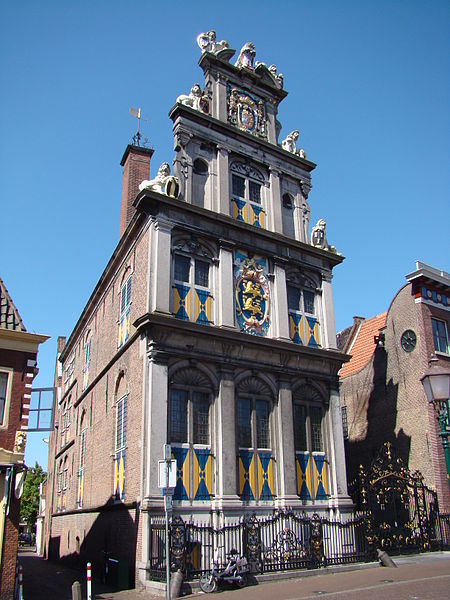
The Westfries Museum is a museum of regional history established in the Dutch city of Hoorn.
It was opened on 10 January 1880 and has been established in a monumental building dating to 1632. This building originally belonged to the Gecommitteerde Raden van West-Friesland en het Noorderkwartier, as a part of the Staten van Holland en West-Friesland, and later became a court. Until 1932 part of the building housed the kanton's court and part of its museum.
The museum has an extensive collection of paintings, silver objects, porcelain, historic firearms, objects of the schutterij and VOC objects. The collection is exhibited in 25 rooms, of which one is a style-room. In 1953, 15th century cellars were discovered under the building. These have been restored and are now used as exhibition spaces for archaeological objects from Hoorn and its surroundings.
The museum is supported by the Friends Foundation of the Westfries Museum that was set up on the initiative of the Westfries Society.
On 10 January 2005, the night the museum celebrated its 125th anniversary, four people stole 21 paintings of its paintings, including a piece by Jan van Goyen from his youth, and part of the silver collection, valued in the millions of Euros. Four of the paintings were found back in Ukraine in April 2016.
Notable buildings
Hoorn has a very high number of surviving 17th and 18th century houses, especially north of the harbour area, adding much to the character of the area. Other notable buildings include:
The main Protestant church on Kerkplein, converted to shops and community uses in 1997 but currently (2018) closed.
The Waag (17th-century weigh-house) at the junction of Grote Oost and the main town square
The 15th-century Hoofdtoren, the old harbour control building
A very fine line of 17th-century houses and original shop-fronts on the harbour edge at Hoofd
'T Wees Huys (1620) on Achterstraat
The Claes Stapelhof (1682) on the Munnickenveld straat
Maria or Kruittoren (1508), on the Achter de Vest, built in late gothic style as part of the city wall. Most of the wall has been taken down but this tower still stands.
Hoorn has notable modern buildings as well, for example:
Schouwburg Het Park, a theatre and congress centre which was opened on 25 June 2004 by Queen Beatrix (since 2013 Princess Beatrix). They started building the theatre in 2000 but due to faulty construction work a part of the theatre (which was not yet finished) came crashing down in the night of 20 April 2001.
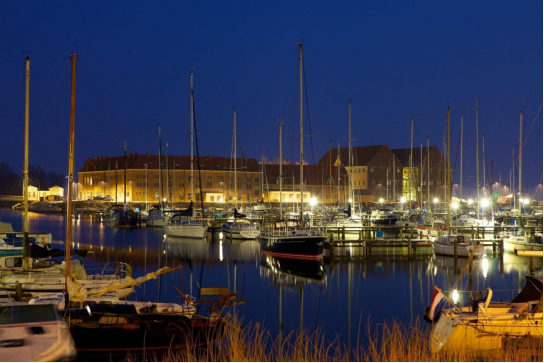
East Island
Oostereiland means for Hoorn that it is immediately a tourist attraction richer. A cultural center and a very beautiful residential location in one. Great to live, work or experience there. And there is a lot to experience. Oostereiland is bustling with life and is accessible to everyone.
Take a walk on the island. Take a look at the courtyard or visit the cinema or museum. Settle down for a drink or a snack and drop in at the tourist information point. Or take a moment to look around on this site. In this way you will discover very quickly what Oostereiland can do for you.
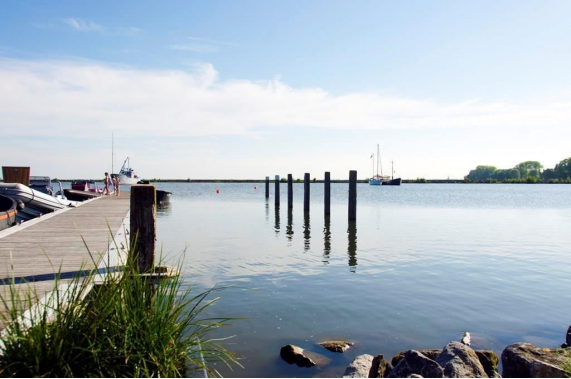
Marina Cape Horn
Welcome to Marina Cape Horn! A unique location on the edge of Hoorn with a beautiful view of the IJsselmeer and Julianapark. Here you come to recreate, relax and enjoy original activities, workshops and events. With the centrally located cozy beach pavilion Oranje Buiten and catering location VOLT, this area is also fully equipped in the catering sector. Take a seat on the terrace or on the sandy beach at Oranje Buiten and enjoy recreation by the water!
Relaxation and enjoyment at Marina Cape Hoorn!
You will also find the slipway of Hoorn here and you can (for a fee of € 5) launch your boat or take it out of the water. Marina Kaap Hoorn is easily accessible by boat, car, bicycle and on foot from Hoorn center. With free parking, this location is ideal for a visit where you can also reach the center of Hoorn by water taxi. In short, a unique location with many options for groups as passers-by, consisting of 30,000 m2 of private land on the edge of Hoorn!
六、历史文化
Founded in 716, Hoorn rapidly grew to become a major harbour town. During Holland's 'Golden Age' (or 'Golden Century'), Hoorn was an important home base for the Dutch East India Company (VOC) and a very prosperous centre of trade. The Hoorn fleet plied the seven seas and returned laden with precious commodities. Exotic spices such as pepper, nutmeg, cloves, and mace were sold at vast profits. With their skill in trade and seafaring, sons of Hoorn established the town's name far and wide. Jan Pieterszoon Coen (1587–1629) is famous for his violent raids in Dutch Indies (now Indonesia), where he "founded" the city of Batavia in 1619 (now Jakarta). He has a big statue on the Rode Steen square in the center of Hoorn.
In 1618 Willem Bontekoe (1587–1657) undertook his first and only voyage for the VOC. His story of his travel and hardship found its way into the history books when he published his adventures in 1646 under the title Journael ofte gedenckwaerdige beschrijvinge van de Oost-Indische reyse van Willem Ysbrantsz. Bontekoe van Hoorn, begrijpende veel wonderlijcke en gevaerlijcke saecken hem daer in wedervaren ('Journal, or memorable description, of the East-Indian voyage of Willem Ysbrantz. Bontekoe of Hoorn, comprising many wondrous and dangerous things experienced by him'). In 1616, the explorer Willem Corneliszoon Schouten braved furious storms as he rounded the southernmost tip of South America. He named it Kaap Hoorn (Cape Horn) in honour of his home town.
Hoorn's fortunes declined somewhat in the eighteenth century. The prosperous trading port became little more than a sleepy fishing village on the Zuiderzee. Following Napoleonic occupation, there was a period during which the town gradually turned its back on the sea. It developed to become the market for the entire West Frisian agricultural region. Stallholders and shopkeepers devoted themselves to trading in dairy produce and seeds. When the railway and metalled roads came to Hoorn in the late nineteenth century, the town rapidly took its rightful place as a conveniently located and readily accessible centre in the network of towns and villages which make up the province of Noord-Holland. In 1932, the Afsluitdijk, or Great Enclosing Dyke, was completed, and Hoorn was no longer a seaport.
The years after the Second World War saw a period of renewed growth. At the centre of a flourishing horticultural region, Hoorn developed an extremely varied economy. During the 1960s, Hoorn was designated an 'overflow' city to relieve pressure on the overcrowded Randstad region. Thousands of people swapped their cramped little apartments in Amsterdam for a family house with garden in one of Hoorn's modern new developments.
On 26 March 2007, Hoorn celebrated 650 years as a city: in 1357 Hoorn was awarded city rights by the Count of Holland after a lump sum payment of 1500 schilden to the Count.
七、其他信息
Etymology
The origin of the name Hoorn, even in old spelling Hoern(e) or Hoirne, is surrounded in myths. Hoorn's name, according to Old Frisian legends, is derived from the stepson of King Redbad (Radboud), called Hornus. Another story about the origin of the name is that it is derived from a sign depicting a post horn in an early 14th-century hanging outside one of the establishments situated on the Roode Steen Square. A third version says that the name was derived from the horn shape of one of its first ports. The author of the 'Origo Civitatis Hornensis' (see page. 256, 'Uit de schemer van Hoorns verleden') assumes that name Hoorn was derived from Damphoorn. Damphoorn is the medieval name for a weed that could be made into whistles, which grew in abundance in the area outside the dykes of Hoorn. Chronicler Velius rejects this statement because there are no old historical entries that Hoorn was called Damphoorn. He wrote: The name was from the start Hoorn: not (against better judgement) derived from the weed Damphoorn, as the current sentiment holds (De name was van eersten af Hoorn: niet (behoudens beter oordeel) van het kruyt Damphoorn, als t'ghemeyne ghevoelen van noch heden hout). Velius also rejects the assertion that the name's origin is Dampter Horn: a neighbourhood of the village Dampten, which flooded and had fallen into disuse.
The name is most probably derived from Hornicwed, a name that is popping up in early mediaeval documents. The medieval meaning of hornic is 'corner', with wed or wedor being the medieval word for water. Many places and neighbourhoods in the Netherlands are called, even today, Heurne, Huurne and Horn. Hornicwed would therefore refer to the location of a corner on the coastline: the location of Hoorn at the Zuiderzee. We see hornic in the meaning of 'corner' also reflected in another municipality in the mediaeval County of Holland: Uithoorn, meaning uithoek, which refers to a certain occupied area (or corner) at some distance.
It is also sometimes argued that hornic refers to a corner in a dike, but this raises doubts: the coast of the Zuiderzee was originally farther away from Hoorn compared to the present day: the Westfriese Omringdijk ran, originating from the West, in a straight line to Schardam and in front of this dyke there were then low-lying tracts of land, where the village of Dampten was located according to Velius. This area was abandoned and flooded after 1391, following the abandonment of the old dyke. A new dyke was built farther inland, resulting in a bay which is now the Hoornse Hop. Hoorn was already in existence then.
Unicorn Events
The city of Hoorn is located in the head of North Holland and has no less than 70,000 inhabitants. Hoorn has a rich VOC history, which means that this city has many sights from its glorious past. Beautiful ornate buildings, famous statues (including Jan Pieterszoon Coen, Scheepsjongens van Bontekoe), the old prison island 'het Oostereiland' and a historic old harbor are some of the special sights of this beautiful city. But in addition to history, Hoorn is above all a city of conviviality with the central square 'de Roode steen' where you can enjoy a drink and snack on one of the many terraces!
八、联系方式
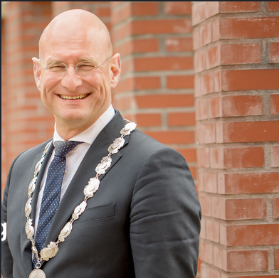
Mayor Jan Nieuwenburg
E-mail: j.nieuwenburg@hoorn.nl
Telephone secretariat: (0229) 25 22 14
Portfolio:
Public order and safety
Regional cooperation
Communication and services
Administrative renewal
Lobby & public affairs
Councilor Marjon van der Ven (VVD)
E-mail: m.vd.ven@hoorn.nl
Telephone secretariat: (0229) 25 22 08
Portfolio:
Finances (including subsidy policy)
Housing and urban renewal
(Youth) Care
Land business / land affairs
Councilor Samir Bashara (GroenLinks)
E-mail: s.bashara@hoorn.nl
Telephone secretariat: (0229) 25 22 11
Portfolio:
Sustainability
Education and preventive youth policy
Traffic, transport and parking
Art, culture, heritage and monuments
visiting address: Nieuwe Steen 1, 1625 HV Hoorn
call the municipality on 0229 25 22 00
Website: https://www.hoorn.nl/
Twitter: Gemeente Hoorn @Gemeente_Hoorn
Facebook: Gemeente Hoorn @gemeentehoorn
